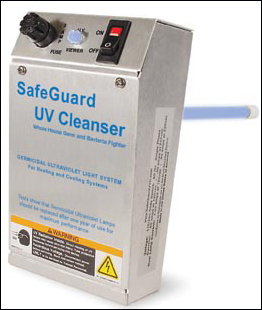QUICK TIPS
Allergies and Asthma Aid: Install a UV Light

Symptoms and Cure for Mold in your Comfort System's Air Stream
The problem
One of the main contributing factors to declining indoor air quality in our homes is that we are building our homes tighter than ever before. There is less outside air infiltration pushing stale polluted air out of the home. Air-borne contaminants and pollutants remain in the air we breathe, to be drawn into our lungs.
Air flowing through our duct systems can be carrying
viruses, mold, dust mites, and bacteria.
Mold, especially can be growing on the indoor coil of your air conditioner or heat pump. This is especially prevalent in heat pumps, due to the lower heat produced when a heat pump is running. A furnace puts out higher temperature air, which tends to kill the microbes that thrive in condensate pans and on evaporator coils.
If your heat pump system smells like "Dirty Socks", mold spores and toxins may be being distributed into the air by the blower.
Today's tighter construction can also allow moisture to build up in unique and hard to get to places, such as inside walls, above ceilings, behind shower walls, and under floors. The best treatment here is prevention. Installation of an air circulation system and a dehumidifier should be considered in the
modern home.
For your heat pump or air conditioning system, cleaning the evaporator coil and condensate pan regularly can help the issue, but the best solution is installation of an Ultra-violet light (UV light). Place one directly over the AC coil, inside the ductwork. Place another one in the return ducting (or cold-air drop) just before the air handler. Uv lights will kill mold and bacteria that thrive in the forced air system.
Ultra-violet radiation
The most effective air purifier known to man is our Sun. Natural sunlight has been cleaning our outside air since before the dawn of man. Ultra-violet radiation (UV-C rays) inhibit the reproduction and growth of bacteria, fungi, viruses, molds, and other allergens and disease-causing microbes.
This natural process does not occur inside our homes. Therefore, we must replicate the process with artificial Ultra-violet lights (UV-C). Combine an ultra-violet light with a good air filtration system and you have taken huge strides toward protecting your family's health and longevity.
Most Hvac manufacturers produce their own version of the ultra-violet light. Many have air cleaners with an integral UV light built in. These units cover the return side of the forced air system, but do little to treat the issue that exists in the coil and pan area of the supply side of the system. Here a separate UV light can be cut in and inserted directly over the evaporator coil.
UV light characteristics / Benefits
1) Lamp does not produce ozone
2) 120 volt operation, plugs into a standard electrical outlet.
3) Continuous operation
4) Effectively kills surface and air-borne bacteria
5) Effectively kills developing mold and mold spores in the air stream, evaporator coil, and condensate pans
6) Can be an integral component of an inline media air cleaner, an inline electronic air cleaner, or a passive high efficiency air cleaner
7) Kills microorganisms as they pass by in the air stream
8) Easily serviceable. Most lamps should be replaced once per year. Some models have an indicator as a reminder to the homeowner to change the lamp
NOTE: Looking directly at the bulb when it is on can harm your eyes. Make sure the unit is unplugged or disabled before removal for servicing.
Read more about Mold and Indoor Air Quality issues
The EPA has superb pages concerning IAQ issues
Filtration ideas
Leave Ultra-Violet Lights and Return to Quick Tips main page
Return to HOME

Please feel free to link to this page from your website. This page's URL is: http://www.perfect-home-hvac-design.com/ultra-violet-lights.html
Enjoy this page? Please pay it forward. Here's how...
Would you prefer to share this page with others by linking to it?
- Click on the HTML link code below.
- Copy and paste it, adding a note of your own, into your blog, a Web page, forums, a blog comment,
your Facebook account, or anywhere that someone would find this page valuable.